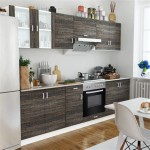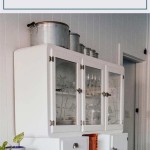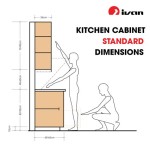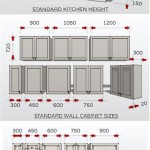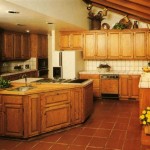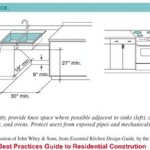Cabinets vs. Drawers in Kitchen Design: A Comparative Analysis
The modern kitchen is a complex ecosystem, carefully designed to maximize efficiency and aesthetic appeal. Central to this endeavor is the choice between cabinets and drawers for storage solutions. While both serve the fundamental purpose of concealing and organizing kitchen essentials, their differing functionalities, spatial requirements, and ergonomic considerations dictate their suitability for various applications. An informed decision regarding cabinets versus drawers requires a thorough understanding of their respective advantages and disadvantages.
Cabinets, traditionally the cornerstone of kitchen storage, consist of a box-like enclosure with a door that swings open to reveal internal shelving. This design offers a cost-effective and versatile storage solution, particularly for larger and taller items. Drawers, conversely, are sliding compartments that extend horizontally from the cabinet frame, providing immediate access to their contents. The optimal blend of cabinets and drawers hinges on a comprehensive evaluation of individual needs and spatial constraints.
Accessibility and Ergonomics
One of the most significant differentiators between cabinets and drawers lies in their accessibility. Drawers provide superior accessibility for items stored at the back. With a single pull, the entire contents of the drawer are exposed, eliminating the need to bend, reach, or rummage through items to locate what is needed. This is particularly advantageous for individuals with mobility limitations or back problems, as it reduces strain and promotes ergonomic efficiency. Cabinets, on the other hand, often require bending and reaching, particularly for items stored on lower shelves or at the back of the cabinet. The visibility within a cabinet is also often compromised, necessitating the removal of front items to access items stored further back.
The ergonomic benefits of drawers extend beyond simple accessibility. The ability to see and retrieve items with minimal physical exertion contributes to a more comfortable and efficient cooking experience. Drawers also facilitate better organization, as items are less likely to be stacked haphazardly, leading to less searching and fumbling. Drawer dividers and organizers can further enhance this benefit, creating dedicated spaces for specific items and ensuring that everything has its designated place.
However, it is important to acknowledge the potential drawbacks of drawers in terms of ergonomic design. Deep drawers, while offering ample storage space, can become heavy and difficult to pull out when fully loaded. This is especially true for drawers used to store pots, pans, or other heavy kitchen equipment. The weight can place strain on the drawer slides, potentially leading to premature wear and tear. Therefore, careful consideration should be given to the weight capacity of the drawer slides and the types of items that will be stored in the drawers. Choosing high-quality, heavy-duty drawer slides is crucial for ensuring smooth and reliable operation.
Storage Capacity and Organization
Cabinets generally offer greater flexibility in accommodating items of varying sizes and shapes. The vertical space within a cabinet can be easily adjusted by repositioning shelves, allowing for customized storage configurations. This is particularly useful for storing tall items, such as vases, pitchers, or standing mixers, which may not fit comfortably in standard drawers. Open shelving within cabinets can also provide a space for displaying decorative items or frequently used kitchen tools.
While cabinets excel in vertical storage, drawers tend to be more efficient for organizing smaller items. Drawers equipped with dividers and inserts can transform chaotic spaces into neatly arranged compartments, making it easier to find and retrieve items. Flatware drawers, spice racks, and utensil organizers are prime examples of how drawers can enhance kitchen organization. Deep drawers, often referred to as pot and pan drawers, provide a dedicated space for storing cookware, preventing them from becoming stacked and cluttered in cabinets.
The perceived storage capacity of cabinets versus drawers can be subjective and dependent on individual organizational habits. Cabinets, if not properly organized, can become cluttered and inefficient, leading to wasted space. Drawers, while inherently more organized, may have a limited overall storage volume compared to large cabinets. The optimal combination of cabinets and drawers should therefore be tailored to specific storage needs and organizational preferences. Consider the types of items that will be stored, their frequency of use, and the available space when deciding on the proportion of cabinets to drawers.
Cost and Installation
Cabinets are generally less expensive to manufacture and install than drawers. The simpler design of a cabinet, with its hinged door and fixed shelving, requires fewer parts and less labor. Drawers, on the other hand, involve more intricate construction, including the creation of the drawer box, the installation of drawer slides, and potentially the addition of drawer fronts and hardware. The cost of high-quality drawer slides, in particular, can significantly increase the overall expense of a drawer-based kitchen design.
The installation of cabinets is also typically more straightforward than the installation of drawers. Cabinets can be easily mounted to the wall and leveled using shims. Drawers, however, require precise alignment and careful adjustment to ensure smooth operation. Improper installation can lead to drawers that stick, wobble, or fail to close properly. Therefore, it is often advisable to seek professional installation for drawer-heavy kitchen designs to ensure optimal functionality and longevity.
While the initial cost of cabinets may be lower, the long-term cost-effectiveness of drawers should also be considered. Drawers, with their superior accessibility and organizational capabilities, can significantly reduce food waste and increase efficiency in the kitchen. The time saved searching for items and the reduced need to replace forgotten or expired ingredients can offset the higher initial investment in drawers. Furthermore, well-maintained drawers can last for many years, providing a valuable return on investment over the lifespan of the kitchen.
Style and Aesthetics
Both cabinets and drawers offer a wide range of stylistic options to complement any kitchen design. Cabinet doors are available in a variety of materials, finishes, and styles, from traditional raised-panel designs to modern flat-panel configurations. Similarly, drawer fronts can be customized to match the cabinet doors, creating a cohesive and unified look. The hardware selected for both cabinets and drawers can further enhance the aesthetic appeal, adding a touch of personality and sophistication.
The visual impact of cabinets versus drawers can also influence the overall aesthetic of the kitchen. Cabinets, with their solid doors, can create a more formal and traditional look. Drawers, especially those with sleek, minimalist designs, tend to lend themselves to a more contemporary aesthetic. The choice between cabinets and drawers should therefore be carefully considered in relation to the desired style and ambiance of the kitchen.
From a design perspective, a balanced combination of cabinets and drawers often yields the most visually appealing and functional kitchen. A judicious use of cabinets for storing larger items and drawers for organizing smaller items can create a sense of order and harmony. Incorporating open shelving within cabinets can also add visual interest and break up the monotony of solid doors. Ultimately, the aesthetic choice between cabinets and drawers is a matter of personal preference and should be guided by the overall design vision for the kitchen.

The Case Of Kitchen Cabinets Vs Drawers Ottawa Copperstone Kitchens Renovation

How To Choose New Kitchen Cabinets And Drawers Aston Black

Doors Vs Drawers Which Is Best For Kitchen Cabinets

How We Organized Our Kitchen Drawers And Cabinets Jenna Sue Design

How To Choose Kitchen Cabinets When Remodeling

What Is Drawer Base Cabinet Definition Of

4 Reasons You Should Choose Drawers Instead Of Lower Cabinets

The Case Of Kitchen Cabinets Vs Drawers Ottawa Copperstone Kitchens Renovation

Kitchen Drawers Vs Cupboard Cabinets What S Best

4 Reasons You Should Choose Drawers Instead Of Lower Cabinets
Related Posts

